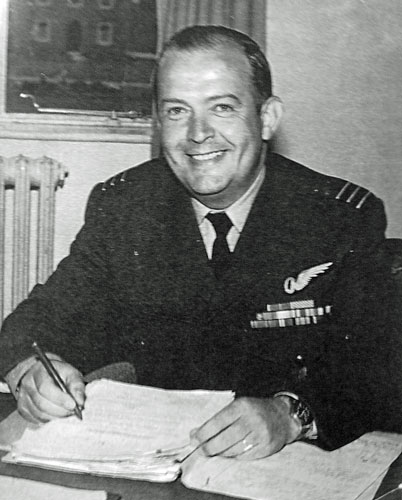The Airmen's Stories - Sgt. R G B Summers
Richard Gordon Battensby Summers was born on 18th October 1921 in Beverley, East Yorkshire and was educated at Ermysteds Grammar School at Skipton. He joined the RAF in April 1939 as a direct-entry Airman u/t Observer.
On 26th June he went to the Bristol Flying School, Yatesbury for basic navigation training, moved to B&GS Warmwell on 30th September and then completed his training with an astro-navigation course at St. Athan in November.

On 4th December 1939 Summers was posted to Church Fenton to join 242 Squadron, then equipped with Blenheims. He went to 219 Squadron at Catterick on 16th April 1940. Summers left the squadron on 28th September to go to the Ferry Pool and Defence Flight Takoradi, in West Africa.
In early July 1941 Summers aircraft made a wheels-up forced-landing on a beach in Liberia. To escape internment he walked 48 miles in bare feet before putting out to sea and being picked up by a British merchantman on the 5th. For this incident, Summers was awarded the AFM (gazetted 1st January 1942).
Commissioned in May 1942, he was posted back to the UK where he was appointed Bombing Leader on Hudsons at No. 1 (Coastal) OTU Silloth on 12th October.
Summers was posted to 48 Squadron at Gibraltar on 22nd May 1943 as Bombing Leader. He returned to the UK and on 1st March 1944 became Bombing Leader at No. 1 APC Aldergrove.
Summers went on a Specialist Armament Course on 19th April, firstly at 2 School of Technical Training Cosford and from late June at the Empire Air Armament School at Manby. He was appointed Armament Staff Officer at HQ 15 Group Liverpool on 17th November 1944 and he moved to RAF Lossiemouth on 7th August 1945 as Station Armament Officer.
Staying in the postwar RAF, in October 1946 Summers was posted to the staff of ACAS (Training) at the Air Ministry as an Acting Squadron Leader.
Pre-selected for the RAF Staff College in 1949, he graduated at the end of 1950 and was appointed Command Weapons Officer at HQ Bomber Command.
From August 1953 until January 1956 Summers was Deputy Station Commander at RAF East Leigh, Kenya during the Mau-Mau Emergency. He was made an OBE (gazetted 6th March 1956) for 'gallant and distinguished services in Kenya'.
Back in the UK, Summers returned to flying and commanded 109 Squadron at Binbrook. In December 1956 he was promoted to Acting Wing Commander and took command of No. 2 Wing RAF Cosford.
In July 1959 he did a RAF Flying College Course at RAF Manby. In January/March 1960 Summers did a conversion course on Vulcans and was then appointed Wing Commander Operations at RAF Finningley, a Vulcan station.
In December 1962 he was posted to the staff of SHAPE in Europe, for 'nuclear activities'. He returned to the UK in December 1966 and became a staff officer in the Department of the Chief of Defence Staff.
Summers retired from the RAF on 18th October 1968 as a Wing Commander.
He died on 7th May 2017.
|